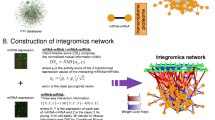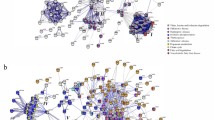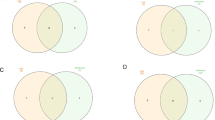Abstract
The scientific research of the sirtuin family represents an intriguing topic for the development of therapies of age-related diseases and anti-ageing treatments. The primary aim of the present study is the identification of the signalling and metabolic pathways facilitating the functions of the sirtuin protein interaction network in longevity and age-related diseases. For this reason, increased confidence protein–protein interaction data were collected from the databases BioGRID, HPRD, MINT, and STRING. The pathway enrichment, the gene function prediction, the cluster analysis and the construction of the sirtuin protein interaction network (SPIN) were executed by GeneMania application, which was combined with the protein node prioritization analysis using cyto-Hubba and the cluster analysis application MCODE. The analysis run under the Cytoscape environment was further complemented by the web-based analysis using STRING and DAVID Bioinformatic resources. TGF-β, AR, ER, CARM1, HDAC class I and Notch signalling pathways significantly scored in the pathway enrichment analysis of the extended SPIN. The cluster analysis using MCODE showed the highest score for the interaction network of Notch together with the AR, CARM and ER signalling subnetworks. Additionally, STRING and DAVID Bioinformatic resources tools also emphasized the functions in the sirtuin-mediated viral infections, which represent an emerging topic. The examination of the SPIN by the cyto-Hubba application highlighted HDAC1, EP300, SMAD4, MYC, SIN3A, RBBP4, HDAC2, SIN3B, RBBP7 and SMAD3 as the high-priority essential protein nodes directing the molecular functions of the whole network. The current protein interaction study provides new insights into the sirtuin functions in the longevity and diseases of ageing, which are further discussed in depth.




Similar content being viewed by others
Abbreviations
- SPIN:
-
Sirtuin protein interaction network
- SPIL:
-
Sirtuin protein interaction list
- TGF-β :
-
Transforming growth factor β
- AR:
-
Androgen receptor
- ER:
-
Oestrogen receptor
- CARM1:
-
Coactivator associated arginine methyltransferase 1
- HDAC:
-
Histone deacetylase
- RB:
-
Retinoblastoma
- MED12:
-
Mediator of RNA polymerase II transcription
References
Oti M. Predicting disease genes using protein–protein interactions. J Med Genet. 2006. https://doi.org/10.1136/jmg.2006.041376.
Csermely P, Ágoston V, Pongor S. The efficiency of multi-target drugs: the network approach might help drug design. Trends Pharmacol Sci. 2005. https://doi.org/10.1016/j.tips.2005.02.007.
Imai SI, Armstrong CM, Kaeberlein M, Guarente L. Transcriptional silencing and longevity protein Sir2 is a NAD-dependent histone deacetylase. Nature. 2000. https://doi.org/10.1038/35001622.
Du J, Zhou Y, Su X, et al. Sirt5 is a NAD-dependent protein lysine demalonylase and desuccinylase. Science. 2011. https://doi.org/10.1126/science.1207861.
Peng C, Lu Z, Xie Z, et al. The first identification of lysine malonylation substrates and its regulatory enzyme. Mol Cell Proteom. 2011. https://doi.org/10.1074/mcp.M111.012658.
Mathias RA, Greco TM, Oberstein A, et al. Sirtuin 4 is a lipoamidase regulating pyruvate dehydrogenase complex activity. Cell. 2014. https://doi.org/10.1016/j.cell.2014.11.046.
Haigis MC, Guarente LP. Mammalian sirtuins—emerging roles in physiology, aging, and calorie restriction. Genes Dev. 2006. https://doi.org/10.1101/gad.1467506.
Burnett C, Valentini S, Cabreiro F, et al. Absence of effects of Sir2 overexpression on lifespan in C. elegans and Drosophila. Nature. 2011. https://doi.org/10.1038/nature10296.
Satoh A, Brace CS, Rensing N, et al. Sirt1 extends life span and delays aging in mice through the regulation of Nk2 Homeobox 1 in the DMH and LH. Cell Metab. 2013. https://doi.org/10.1016/j.cmet.2013.07.013.
McDonnell E, Peterson BS, Bomze HM, et al. SIRT3 regulates progression and development of diseases of aging. Trends Endocrinol Metab. 2015. https://doi.org/10.1016/j.tem.2015.06.001.
Mostoslavsky R, Chua KF, Lombard DB, et al. Genomic instability and aging-like phenotype in the absence of mammalian SIRT6. Cell. 2006. https://doi.org/10.1016/j.cell.2005.11.044.
Michishita E, McCord RA, Berber E, et al. SIRT6 is a histone H3 lysine 9 deacetylase that modulates telomeric chromatin. Nature. 2008. https://doi.org/10.1038/nature06736.
Kanfi Y, Naiman S, Amir G, et al. The sirtuin SIRT6 regulates lifespan in male mice. Nature. 2012. https://doi.org/10.1038/nature10815.
Vakhrusheva O, Smolka C, Gajawada P, et al. Sirt7 increases stress resistance of cardiomyocytes and prevents apoptosis and inflammatory cardiomyopathy in mice. Circ Res. 2008. https://doi.org/10.1161/CIRCRESAHA.107.164558.
Liu M, Liang K, Zhen J, et al. Sirt6 deficiency exacerbates podocyte injury and proteinuria through targeting Notch signaling. Nat Commun. 2017. https://doi.org/10.1038/s41467-017-00498-4.
Stark C. BioGRID: a general repository for interaction datasets. Nucleic Acids Res. 2006. https://doi.org/10.1093/nar/gkj109.
Keshava Prasad TS, Goel R, Kandasamy K, et al. Human Protein Reference Database—2009 update. Nucleic Acids Res. 2009. https://doi.org/10.1093/nar/gkn892.
Licata L, Briganti L, Peluso D, et al. MINT, the Molecular Interaction Database: 2012 update. Nucleic Acids Res. 2012. https://doi.org/10.1093/nar/gkr930.
Szklarczyk D, Gable AL, Lyon D, et al. STRING v11: protein–protein association networks with increased coverage, supporting functional discovery in genome-wide experimental datasets. Nucleic Acids Res. 2019. https://doi.org/10.1093/nar/gky1131.
Warde-Farley D, Donaldson SL, Comes O, et al. The GeneMANIA prediction server: ageing network integration for gene prioritization and predicting gene function. Nucleic Acids Res. 2010. https://doi.org/10.1093/nar/gkq537.
Chin C, Chen S-H, Wu H. Cyto-Hubba: a cytoscape plug-in for hub object analysis in network biology. BMC Syst Biol. 2014. https://doi.org/10.1186/1752-0509-8-S4-S11.
Bader GD, Hogue CWV. An automated method for finding molecular complexes in large protein interaction networks. BMC Bioinform. 2003. https://doi.org/10.1186/1471-2105-4-2.
Huang DW, Sherman BT, Lempicki RA. Systematic and integrative analysis of large gene lists using DAVID bioinformatics resources. Nat Protoc. 2008. https://doi.org/10.1038/nprot.2008.211.
Zuberi K, Franz M, Rodriguez H, et al. GeneMANIA prediction server 2013 update. Nucleic Acids Res. 2013. https://doi.org/10.1093/nar/gkt533.
Franz M, Rodriguez H, Lopes C, et al. GeneMANIA update 2018. Nucleic Acids Res. 2018. https://doi.org/10.1093/nar/gky311.
Zerr P, Palumbo-Zerr K, Huang J, et al. Sirt1 regulates canonical TGF-β signalling to control fibroblast activation and tissue fibrosis. Ann Rheum Dis. 2014. https://doi.org/10.1136/annrheumdis-2014-205740.
Wei J, Ghosh AK, Chu H, et al. The histone deacetylase sirtuin 1 is reduced in systemic sclerosis and abrogates fibrotic responses by targeting transforming growth factor β signaling. Arthritis Rheumatol. 2015. https://doi.org/10.1002/art.39061.
Huang K, Huang J, Xie X, et al. Sirt1 resists advanced glycation end products-induced expressions of fibronectin and TGF-β1 by activating the Nrf2/ARE pathway in glomerular mesangial cells. Free Radic Biol Med. 2013. https://doi.org/10.1016/j.freeradbiomed.2013.07.029.
Huang XZ, Wen D, Zhang M, et al. Sirt1 activation ameliorates renal fibrosis by inhibiting the TGF-β/Smad3 pathway. J Cell Biochem. 2014. https://doi.org/10.1002/jcb.24748.
Li J, Qu X, Ricardo SD, et al. Resveratrol inhibits renal fibrosis in the obstructed kidney: potential role in deacetylation of Smad3. Am J Pathol. 2010. https://doi.org/10.2353/ajpath.2010.090923.
Gao P, Xu TT, Lu J, et al. Overexpression of SIRT1 in vascular smooth muscle cells attenuates angiotensin II-induced vascular remodeling and hypertension in mice. J Mol Med. 2014. https://doi.org/10.1007/s00109-013-1111-4.
Kume S, Haneda M, Kanasaki K, et al. SIRT1 inhibits transforming growth factor beta induced apoptosis in glomerular mesangial cells via Smad7 deacetylation. J Biol Chem. 2007. https://doi.org/10.1074/jbc.M605904200.
Sundaresan NR, Bindu S, Pillai VB, et al. SIRT3 blocks aging-associated tissue fibrosis in mice by deacetylating and activating glycogen synthase kinase 3β. Mol Cell Biol. 2016. https://doi.org/10.1128/MCB.00586-15.
Minagawa S, Araya J, Numata T, et al. Accelerated epithelial cell senescence in IPF and the inhibitory role of SIRT6 in TGF-β-induced senescence of human bronchial epithelial cells. Am J Physiol Cell Mol Physiol. 2011. https://doi.org/10.1152/ajplung.00097.2010.
Feng XX, Luo J, Liu M, et al. Sirtuin 6 promotes transforming growth factor-β1/H2O2/HOCl-mediated enhancement of hepatocellular carcinoma cell tumorigenicity by suppressing cellular senescence. Cancer Sci. 2015. https://doi.org/10.1111/cas.12632.
Tang X, Shi L, Xie N, et al. SIRT7 antagonizes TGF-β and inhibits breast cancer metastasis. Nat Commun. 2017. https://doi.org/10.1038/s41467-017-00396-9.
Wang H, Liu S, Liu S, et al. Enhanced expression and phosphorylation of Sirt7 activates smad2 and ERK signaling and promotes the cardiac fibrosis differentiation upon angiotensin-II stimulation. PLoS ONE. 2017. https://doi.org/10.1371/journal.pone.0178530.
Lei W, Zhang K, Pan X, et al. Histone deacetylase 1 is required for transforming growth factor-β1-induced epithelial-mesenchymal transition. Int J Biochem Cell Biol. 2010. https://doi.org/10.1016/j.biocel.2010.05.006.
Liu N, He S, Ma L, et al. Blocking the class I histone deacetylase ameliorates renal fibrosis and inhibits renal fibroblast activation via modulating TGF-β and EGFR signaling. PLoS ONE. 2013. https://doi.org/10.1371/journal.pone.0054001.
Noh H, Oh EY, Seo JY, et al. Histone deacetylase-2 is a key regulator of diabetes- and transforming growth factor-β1-induced renal injury. AJP Ren Physiol. 2009. https://doi.org/10.1152/ajprenal.00086.2009.
Koyuncu E, Budayeva HG, Miteva YV, et al. Sirtuins are evolutionarily conserved viral restriction factors. MBio. 2014. https://doi.org/10.1128/mBio.02249-14.
Ren J-H, Tao Y, Zhang Z-Z, et al. Sirtuin 1 regulates Hepatitis B virus transcription and replication by targeting transcription factor AP-1. J Virol. 2014. https://doi.org/10.1128/jvi.02861-13.
Pagans S, Pedal A, North BJ, et al. SIRT1 regulates HIV transcription via Tat deacetylation. PLoS Biol. 2005. https://doi.org/10.1371/journal.pbio.0030041.
Langsfeld ES, Bodily JM, Laimins LA. The Deacetylase sirtuin 1 regulates human Papillomavirus replication by modulating histone acetylation and recruitment of DNA damage factors NBS1 and Rad51 to viral genomes. PLoS Pathog. 2015. https://doi.org/10.1371/journal.ppat.1005181.
Hackett BA, Dittmar M, Segrist E, et al. Sirtuin inhibitors are broadly antiviral against arboviruses. MBio. 2019. https://doi.org/10.1128/mBio.01446-19.
Li Q, He M, Zhou F, et al. Activation of Kaposi’s sarcoma-associated herpesvirus (KSHV) by inhibitors of class III histone deacetylases: identification of sirtuin 1 as a regulator of the KSHV life cycle. J Virol. 2014. https://doi.org/10.1128/jvi.00219-14.
Dai Y, Ngo D, Forman LW, et al. Sirtuin 1 is required for antagonist-induced transcriptional repression of androgen-responsive genes by the androgen receptor. Mol Endocrinol. 2007. https://doi.org/10.1210/me.2006-0467.
Fu M, Liu M, Sauve AA, et al. Hormonal control of androgen receptor function through SIRT1. Mol Cell Biol. 2006. https://doi.org/10.1128/MCB.00289-06.
Cheng D, Vemulapalli V, Lu Y, et al. CARM1 methylates MED12 to regulate its RNA binding ability. Life Sci Alliance. 2018. https://doi.org/10.26508/lsa.201800117.
Pang L, Tian H, Chang N, et al. Loss of CARM1 is linked to reduced HuR function in replicative senescence. BMC Mol Biol. 2013. https://doi.org/10.1186/1471-2199-14-15.
Potente M, Ghaeni L, Baldessari D, et al. SIRT1 controls endothelial angiogenic functions during vascular growth. Genes Dev. 2007. https://doi.org/10.1101/gad.435107.
Yao Y, Li H, Gu Y, Davidson NE. Inhibition of SIRT1 deacetylase suppresses estrogen receptor signaling. Carcinogenesis. 2010. https://doi.org/10.1093/carcin/bgp308.
Xie M, Liu M, He CS. SIRT1 regulates endothelial Notch signalling in lung cancer. PLoS ONE. 2012. https://doi.org/10.1371/journal.pone.0045331.
Wang L, Wang WY, Cao LP. SIRT3 inhibits cell proliferation in human gastric cancer through down-regulation of Notch-1. Int J Clin Exp Med. 2015;8:5263–71.
Guarente L. Calorie restriction and sirtuins revisited. Genes Dev. 2013. https://doi.org/10.1101/gad.227439.113.
Sun D, Luo M, Jeong M, et al. Epigenomic profiling of young and aged HSCs reveals concerted changes during aging that reinforce self-renewal. Cell Stem Cell. 2014. https://doi.org/10.1016/j.stem.2014.03.002.
De Lorenzo MS, Baljinnyam E, Vatner DE, et al. Caloric restriction reduces the growth of mammary tumors and metastases. Carcinogenesis. 2011. https://doi.org/10.1093/carcin/bgr107.
Doyle KP, Cekanaviciute E, Mamer LE, Buckwalter MS. TGFβ signaling in the brain increases with aging and signals to astrocytes and innate immune cells in the weeks after stroke. J Neuroinflamm. 2010. https://doi.org/10.1186/1742-2094-7-62.
Salvioli S, Capri M, Bucci L, et al. Why do centenarians escape or postpone cancer? The role of IGF-1, inflammation, and p53. Cancer Immunol Immunother. 2009. https://doi.org/10.1007/s00262-008-0639-6.
Finch CE, Laping NJ, Morgan TE, et al. TGF-βl is an organizer of responses to neurodegeneration. J Cell Biochem. 1993. https://doi.org/10.1002/jcb.240530408.
Tesseur I, Zou K, Esposito L, et al. Deficiency in neuronal TGF-β signaling promotes neurodegeneration and Alzheimer’s pathology. J Clin Invest. 2006. https://doi.org/10.1172/JCI27341.
Caraci F, Battaglia G, Bruno V, et al. TGF-β1 pathway as a new target for neuroprotection in Alzheimer’s disease. CNS Neurosci Ther. 2011. https://doi.org/10.1111/j.1755-5949.2009.00115.x.
Chang HC, Guarente L. SIRT1 mediates central circadian control in the SCN by a mechanism that decays with aging. Cell. 2013. https://doi.org/10.1016/j.cell.2013.05.027.
Xu M, Pirtskhalava T, Farr JN, et al. Senolytics improve physical function and increase lifespan in old age. Nat Med. 2018. https://doi.org/10.1038/s41591-018-0092-9.
Frippiat C, Chen QM, Zdanov S, et al. Subcytotoxic H2O2 stress triggers a release of transforming growth factor-β1, which induces biomarkers of cellular senescence of human diploid fibroblasts. J Biol Chem. 2001. https://doi.org/10.1074/jbc.M006809200.
Tasselli L, Zheng W, Chua KF. SIRT6: novel mechanisms and links to aging and disease. Trends Endocrinol Metab. 2017. https://doi.org/10.1016/j.tem.2016.10.002.
Ghosh S, Liu B, Wang Y, et al. Lamin A is an endogenous SIRT6 activator and promotes SIRT6-mediated DNA repair. Cell Rep. 2015. https://doi.org/10.1016/j.celrep.2015.10.006.
Picard F, Kurtev M, Chung N, et al. Sirt1 promotes fat mobilization in white adipocytes by repressing PPAR-γ. Nature. 2004. https://doi.org/10.1038/nature02583.
Frescas D, Valenti L, Accili D. Nuclear trapping of the forkhead transcription factor FoxO1 via sirt-dependent deacetylation promotes expression of glucogenetic genes. J Biol Chem. 2005. https://doi.org/10.1074/jbc.M412357200.
Naiman S, Huynh F, Gil R, Glick Y, et al. SIRT6 promotes hepatic β-oxidation via activation of PPARα. Cell Rep. 2019. https://doi.org/10.1016/j.celrep.2019.11.067.
Yoshizawa T, Karim MF, Sato Y, et al. SIRT7 controls hepatic lipid metabolism by regulating the ubiquitin-proteasome pathway. Cell Metab. 2014. https://doi.org/10.1016/j.cmet.2014.03.006.
Horstman AM, Dillon EL, Urban RJ. The role of androgens and estrogens on healthy aging and longevity. J Gerontol Biol Sci Med Sci. 2012. https://doi.org/10.1093/gerona/gls068.
Koltai E, Szabo Z, Atalay M, et al. Exercise alters SIRT1, SIRT6, NAD and NAMPT levels in skeletal muscle of aged rats. Mech Ageing Dev. 2010. https://doi.org/10.1016/j.mad.2009.11.002.
Kovacheva EL, Sinha Hikim AP, Shen R, et al. Testosterone supplementation reverses sarcopenia in aging through regulation of myostatin, c-Jun NH2-terminal kinase, Notch, and Akt signaling pathways. Endocrinology. 2010. https://doi.org/10.1210/en.2009-1177.
Ghosh S, Zhou Z. SIRTain regulators of premature senescence and accelerated aging. Protein Cell. 2015. https://doi.org/10.1007/s13238-015-0149-1.
Acknowledgements
The research was conducted from the financial resources of Biochemworld Co., Uppsala County, Sweden.
Author information
Authors and Affiliations
Corresponding author
Ethics declarations
Conflict of interest
There is no conflict to declare.
Additional information
Publisher's Note
Springer Nature remains neutral with regards to jurisdictional claims in published maps and institutional affiliations.
Electronic supplementary material
Below is the link to the electronic supplementary material.
Table 1S
The sirtuin protein interaction list (SPIL) and the protein description used in the pathway enrichment and protein function prediction analysis (XLSX 12 kb)
Table 2S
The results of the pathway enrichment analysis using the KEGG pathways analysis of the STRING (v.11) database with FDR value less or equal to 0.05 (XLSX 15 kb)
Table 3S
The results of the pathway enrichment using the Reactome pathways analysis of STRING (v.11) database with FDR value less or equal to 0.05 (XLSX 25 kb)
Table 4S
The results of the pathway enrichment using the KEGG pathways analysis of DAVID Bioinformatic resources (version 6.8), with FDR value less or equal to 0.05 (XLSX 11 kb)
Rights and permissions
About this article
Cite this article
Nahálková, J. Exploring the Sirtuin Functionality in Ageing Through Human Protein Interaction Networks. SN COMPUT. SCI. 1, 183 (2020). https://doi.org/10.1007/s42979-020-00192-1
Received:
Accepted:
Published:
DOI: https://doi.org/10.1007/s42979-020-00192-1




